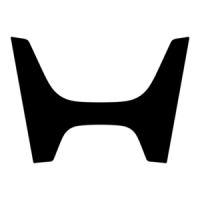COOLING
GENERAL
Removing the radiator cap while the engine is hot can allow
the
coolant
to
spray out, seriously scalding you.
Always let the engine and radiator cool down before removing the radiator cap.
I
NOTICE
I
Using coolant with silicate corrosion inhibitors may cause premature wear
of
water pump seals
or
blockage
of
radiator passages.
Using tap water
may
cause engine damage.
• Add coolant at the reserve tank.
Do
not remove the radiator cap except
to
refill or drain the system.
• All cooling system can be serviced with the engine
in
theframe.
• Avoid spilling coolant
on
painted surfaces.
• After servicing the system, check for leaks with a cooling system tester.
SPECIFICATIONS
ITEM
Coolant capacity
Radiator
and
engine
Reserve tank
'13 model
After '13 model
Radiator cap relief pressure
Thermostat
Begin to open
'13 model
After '13 model
Fully open
'13 model
After '13 model
Valve lift
'13 model
After '13 model
Recommended antifreeze
Standard coolant concentration
TORQUE VALUES
ITEM
QTY
Radiator drain bolt
1
Radiator base screw
1
Radiator top cover screw
4
Engine temperature too high
• Thermostat stuck closed
• Faulty radiator cap
• Insufficient coolant
Passage blocked
in
radiator, hoses or water jacket
• Air
in
system
• Faulty water pump
Engine temperature too low
• Thermostat stuck open
Coolant leak
• Deteriorated 0-rings
• Faulty radiator cap
• Damaged or deteriorated cylinder head gasket
• Loose hose connection or clamp
• Damaged or deteriorated hoses
SPECIFICATIONS
0.48 liter
(0.51
US
qt,
0.42 Imp qt)
0.18 liter (0.19
US
qt, 0.16 Imp qt)
0.054 liter (0.057
US
qt, 0.047 Imp qt)
108 - 137 kPa
(1.1
- 1.4 kgf/cm
2
,
16 -
20
psi)
74-
78
°C
(165-
172 °F)
84-
88
°C (183 - 190 °F)
100°C(212°F)
95
°C
(203 °F)
8 mm (0.3 in) minimum
5.3
mm
(0.2 in) minimum
Pro
Honda
HP
Coolant or
an
equivalent high quality ethylene
glycol antifreeze containing silicate-free corrosion inhibitors
1
:1
(mixture with distilled water)
THREAD TORQUE
REMARKS
DIA. (mm)
N·m (kgf·m, lbMt)
10
1(0.1,0.7)
4
0.8 (0.08, 0.6)
4
3.2 (0.33, 2.4)

